Services
Services
S-PLANT Dental Hospital provide one-stop dental solutions under one roof since we are a complete dental facility and incorporating the latest dental technology into our practice so as to give patients innovative, leading edge treatments to personalized care which are safer, faster, more convenient and more effective.
We are the first digitalized dental hospital in Korea have used advanced digital technology into dental practice. Our dental clinics utlizies 3D CT Scans, digitalized x-ray machines, surgicial safety units, CoDiagnostix 3D Digital Guide and abides by a strict treatment pathway for all our surgical cases complying with global standards.
We are the first digitalized dental hospital in Korea have used advanced digital technology into dental practice. Our dental clinics utlizies 3D CT Scans, digitalized x-ray machines, surgicial safety units, CoDiagnostix 3D Digital Guide and abides by a strict treatment pathway for all our surgical cases complying with global standards.

S-PLANT Implant
- What is Dental Implant?
- Types of Dental Implants
- Bone Grafts
Dental Implants are Titanium posts that are surgically placed into the jaw bone when there are damaged or missing teeth with artificial teeth that look and function much like real ones. Dental implants are the number one choice for replacing teeth.
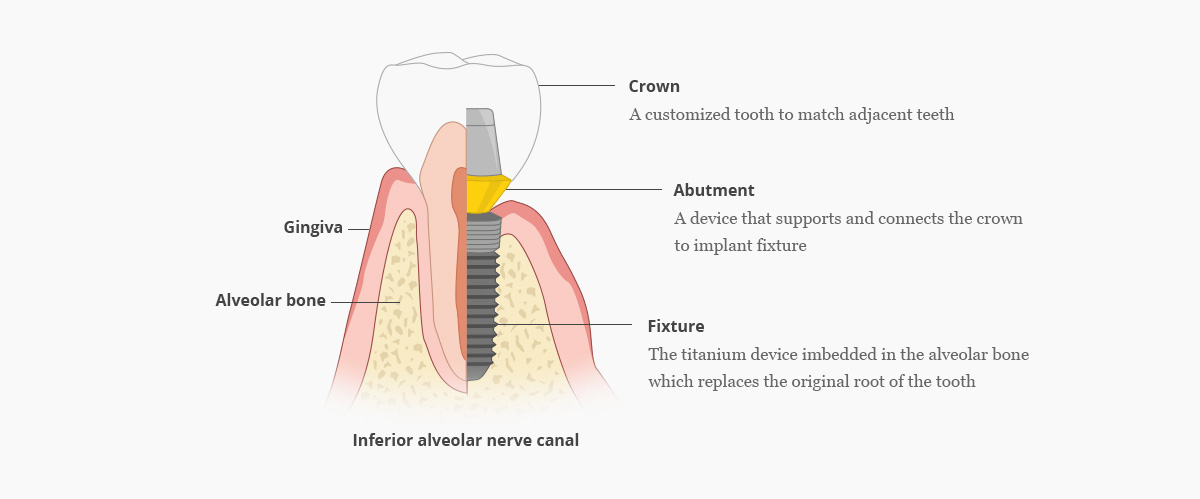
S-PLANT is specialized in 3D virtual implants planning for implant positions using cone beam CT data and this improve the accuracy of implant placement.
Our strength as a top dental implant center lays due to its highly certified and well experienced team of implantologists and prosthodontists. All our dentists have over 20 years of experience and our group of implant specialists are verified as well as granted the scope privileges for implant treatment.
Our strength as a top dental implant center lays due to its highly certified and well experienced team of implantologists and prosthodontists. All our dentists have over 20 years of experience and our group of implant specialists are verified as well as granted the scope privileges for implant treatment.
The Implant system of S-PLANT is diffrent!
'Faster ,Safer and more Accurate!'

S-PLANT Dental Implant Diagnosis and Procedures
" It is possible in 1 Day at S-PLANT! "
- 01. Diagnosis
-
 Panorama Taking
3D I-CAT CT Scanning
Panorama Taking
3D I-CAT CT Scanning
- 02. Planning
-
 3D Virtual Implant Planning
Consultation
3D Virtual Implant Planning
Consultation
- 03. Surgical Guide Preparation

- 04. Virtual Provisional(temporary) Crown Preparation

- 05. Aroma Therapy / Air Shower

- 06. Implant Surgery & Immediate Loading (Provisional crown)

-
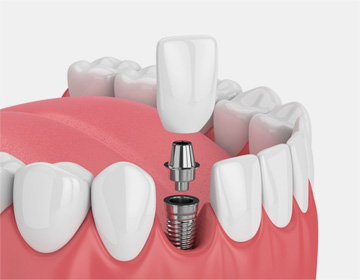
Conventional Implants (Single, Multiple, Full Arch)
Conventional implants are applicable to almost anyone who is looking to replace one, multiple, all missing teeth with a permanent restoration solution. Conventional implants are done in 2 stages normally in 2 trips about 2 to 6 months apart. Conventional implants may be done for most types of bone conditions. If there is moderate or severe jaw bone loss, bone grafting may be needed with dental implantation. -
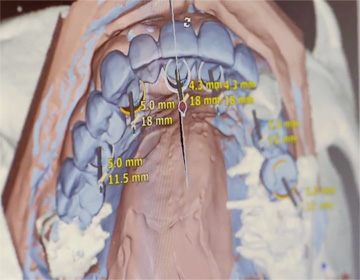
3D Guided Implants
Guided implant surgery is the process of planning the implant surgery on a computer using the patient’s CT image. The conventional method of using the patient’s panoramic x-ray to plan implant surgery cannot transfer the planning exactly as planned, however, guided implant surgery can transfer the plan as exactly as the doctor plans on the computer. To carry out the surgery exactly as the surgery plan, a custom surgical template and guided implant surgery kit are needed. -
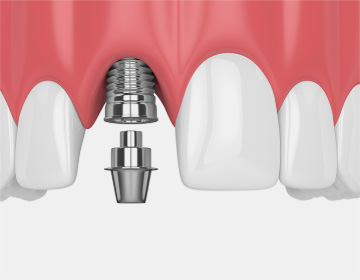
Flapless Implants
Flapless implant surgery using surgical guide can shortens treatment times, surgery times and reduces swelling. -
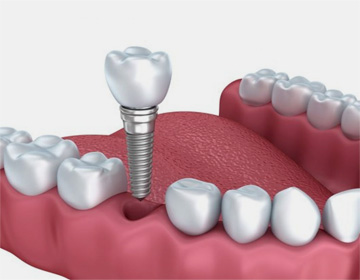
Immediate Implants
Immediate implants are also known as one-day or same day implants. This is the case whereby dental implants are placed during the same time after teeth are extracted. Immediate implants are normally recommended only for cases with good jaw bone conditions and density.- Less invasi ve as tooth is extracted and implant post placed in one surgical visit when gums and bones are only opened once relative to 2 separate surgical visits
- Shorter treatment time and less trips or visits as implant posts is inserted immediately after tooth extraction
-
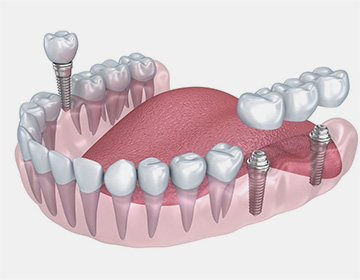
Immediate Loaded Implants
Immediate loaded implants are whereby permanent or temporary crowns, bridges or dentures are placed during the same trip when the dental implant posts are embedded in jaws. It is also known as immediate function implants. Immediate loaded implants may follow after conventional implants or immediate implants. Immediate loaded implants are normally recommended only for cases with good jawbone conditions. The immediate loading of dental implants shortens the treatment time and makes it possible to give the patient an aesthetic appearance during the whole treatment period.- Immediately functioning teeth
- Good aesthetic results
- Shorter treatment time with minimized pain
-
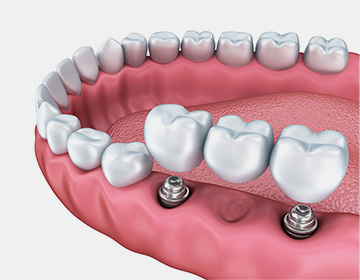
Implant-Supported Bridge
An implant-supported bridge is similar to a regular dental bridge, but it is supported by implants and not by natural teeth. In most cases, when an implant-supported bridge is used, one implant is placed in the jawbone for each missing tooth. Then the crowns are connected to each other to form one piece.

Bone grafting procedures are usually necessary if there is not enough bone available to place dental implants or if any vital anatomy is in the way. Loss of bone volume can be caused by a variety of factors due to :
- 1. infection
- 2. trauma
- 3. periodontal (gum) disease
If a patient lost a tooth and leaves the gap over a long period of time. It is likely that the bone around the lost tooth has degenerated to some degree and needs to be augmented before it can support a dental implant. This is usually a result of bone resorption that has taken place since one or more teeth (if not all) were lost. Bone Grafting procedures usually try to re-establish bone dimension, which was lost due to resorption.
Many years ago the lack of bone posed a considerable problem and sometimes implant placement was impossible because of that. Today, however, humans now have the ability to grow bone where needed. This not only gives us the opportunity to place implants of proper length and width and gives us a chance to restore the esthetic appearance and functionality better. Today, bone grafting procedures have become almost an integral part of implant reconstruction.
Many years ago the lack of bone posed a considerable problem and sometimes implant placement was impossible because of that. Today, however, humans now have the ability to grow bone where needed. This not only gives us the opportunity to place implants of proper length and width and gives us a chance to restore the esthetic appearance and functionality better. Today, bone grafting procedures have become almost an integral part of implant reconstruction.
Types of Bone Grafting
-
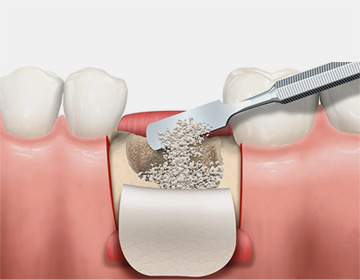
Bone Grafting
Bone grafting involves adding bone material to the affected area. Bone grafting procedures can be easily obtained from other areas of the jaw or from pre-packaged bone graft mineral. -
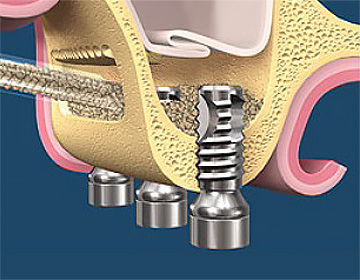
Sinus Lift (Crestal / Lateral window approach)
The maxillary sinuses are empty pockets behind your cheeks, above of your upper back teeth. Sometimes after an upper back tooth is removed and the socket heals, only a thin layer of bone will remain under the sinus. -
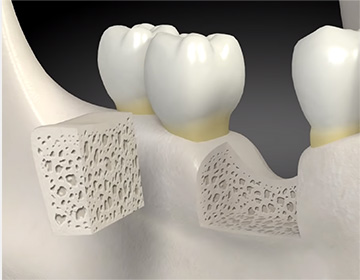
Ridge Augmentation
When teeth have been missing for extended periods of time, the bone remaining in the area may become too narrow and/or too short for implant placement. In these instances, small, carefully prepared and fitted grafts can be placed at the implant sites to provide adequate bone thickness and/or height.
